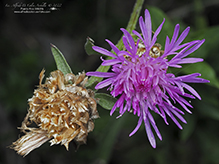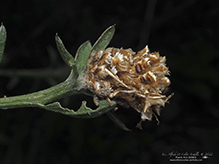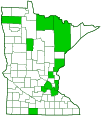brown knapweed
(Centaurea jacea)
Conservation • Weed • Wetland • Description • Habitat • Ecology • Use • Distribution • Taxonomy
Description |
Brown knapweed is an exotic, herbaceous, weedy plant. It is native to Europe, western Asia, and North Africa. The precise timing and location of its introduction to North America is uncertain. It was likely introduced as a contaminant of forage seed or intentionally as a forage plant. It now occurs in the United States in the east from Maine to Maryland, west to Minnesota and Illinois, and south along the Appalachian Mountains to North Carolina. It occurs on the West Coast from northern Washington to northern California. There are just a handful of scattered records between these two ranges. It also occurs in southern Canada from Nova Scotia to Ontario and in British Columbia. Brown knapweed is found in grasslands, meadows, fields, pastures, woodland openings, open woodlands, forest clearcuts, roadsides, ditches, and disturbed areas. It grows under full or partial sun, in moist soil. Brown knapweed spreads rapidly along roadsides, agricultural fields, overgrazed pastures, and other disturbed areas. It can create dense stands that crowd out native species. The roots exude toxic chemicals into the soil that inhibit the growth and survival of competing species (allelopathy). Brown knapweed is an erect, perennial forb that rises on basal leaves and one to a few stems, often from a short rhizome. It can be 1′ to 5′ (30 to 150 cm) in height, but it is usually no more than 4′ (122 cm) tall. In the first year, a rosette of basal leaves is produced. Basal leaves are stalked, hairy, inversely lance-shaped or elliptic in outline, and 2″ to 10″ (5 to 25 cm) long. The margins may be irregularly shallowly lobed, shallowly toothed, or unlobed and untoothed (entire). The surfaces are rough to the touch due to short, stiff, branched hairs, and they are sparsely covered with long, soft, shaggy, unmatted hairs, or short, soft, matted or tangled, woolly hairs. As the plant ages, the leaves become increasingly less hairy. In the second and subsequent years, one to a few flowering stems are produced. The stem is erect or ascending and openly branched near the top. It is rough to the touch due to short, stiff, branched hairs. It has long, soft, shaggy, unmatted hairs, and short, soft, matted or tangled, woolly hairs. As the plant ages, the stem becomes increasingly less hairy. Lower stem leaves are alternate and similar to basal leaves. The leaves become progressively smaller, shorter stalked, and less lobed as they ascend the stem. Middle and upper stem leaves are mostly stalkless. The leaf blade either does not or only slightly extends down the stem. Upper stem leaves are unstalked, linear to lance-shaped, and minutely toothed or entire. The leaf blade does not extend down the stem. Flowering occurs from July through October. The inflorescence is a single flower head or a loose, branched, cyme-like cluster of a few flower heads at the end of the stem and each branch. Each flower head is 1″ to 1¼″ (25 to 32 mm) in diameter. At the base of each flower head is an egg-shaped to bell-shaped, ⅝″ to 11⁄16″ (15 to 18 mm) in diameter whorl of bracts (involucre). Each bract of the involucre (phyllary) is closely appressed at the base, with a rounded, expanded appendage at the tip. The appendage is erect, light brown, and overlapping. The margin is pale, thin, papery, erect, and coarsely toothed. It does not have sharp spines or black curved bristles “eyelashes” at the tip. The green base is usually concealed by the expanded, light brown appendages. This is the feature that gives the species its common name. There are 40 to 100 or more disk florets and no ray florets. The outermost disk florets are enlarged, sterile, and purple, rarely white. They may appear ray-like, but closer examination shows them to be short tubes with 5 long lobes. The inner florets are ⅝″ to 11⁄16″ (15 to 18 mm) long and fertile. They are purple, often becoming paler to white at the center. The sterile florets are longer than the fertile florets. The fruit is a dry, tan, finely hairy, 1⁄16″ to ⅛″ (2 to 3 mm) long seed capsule (cypsela) with a single seed. There is no tuft of bristles (pappus) at the tip. |
Height |
1′ to 5′ (30 to 150 cm) |
Flower Color |
Purple |
Similar Species |
Habitat |
Moist. Grasslands, meadows, fields, pastures, woodland openings, open woodlands, forest clearcuts, roadsides, ditches, and disturbed areas. Full to partial sun. |
Ecology |
Flowering |
July through October |
Pests and Diseases |
|
Use |
|
Distribution |
||
|
Sources |
|
| 4/1/2025 | ||
Nativity |
||
Native to Europe, western Asia, and North Africa |
||
Occurrence |
||
|
||
Taxonomy |
|
Kingdom |
|
| Division |
Tracheophyta (Vascular Plants) |
Subdivision |
Spermatophytina (Seed Plants) |
Class |
|
Order |
Asterales (Sunflowers, Bellflowers, Fanflowers, and Allies) |
Family |
Asteraceae (Sunflowers, Daisies, Asters, and Allies) |
Subfamily |
Carduoideae (thistles and allies) |
Tribe |
Cardueae |
Subtribe |
Centaureinae (knapweeds and allies) |
Genus |
Centaurea (knapweeds) |
Subgenus |
Centaurea |
Section |
Phrygia (common knapweed complex) |
Species |
Centaurea stoebe (spotted knapweed) |
Subordinate Taxa |
|
Several subspecies of Centaurea jacea are recognized in Europe—9, 11, or 12, depending on the source. North American sources do not differentiate the subspecies in North American material. |
|
brown knapweed (Centaurea jacea ssp. angustifolia) brown knapweed (Centaurea jacea ssp. banatica) brown knapweed (Centaurea jacea ssp. dracunculifolia) brown knapweed (Centaurea jacea ssp. forojuliensis) brown knapweed (Centaurea jacea ssp. haynaldii) brown knapweed (Centaurea jacea ssp. jacea) brown knapweed (Centaurea jacea ssp. substituta) brown knapweed (Centaurea jacea ssp. timbalii) brown knapweed (Centaurea jacea ssp. vinyalsii) brown knapweed (Centaurea jacea ssp. weldeniana) Gaudini’s cornflower (Centaurea jacea ssp. gaudinii) Julian knapweed (Centaurea jacea ssp. julica) |
|
Synonyms |
|
Behen jacea Centaurea consimilis Centaurea croatica Centaurea decumbens Centaurea hastata Centaurea humifusa Centaurea commutata Centaurea jacea f. jacea Centaurea jacea f. majuscula Centaurea jacea f. scopulicola Centaurea jacea var. genuina Centaurea jacea var. jacea Centaurea jacea var. pinnatifida Centaurea jungens Centaurea lacera Centaurea lusitanica Centaurea majuscula Centaurea media Centaurea mollis Centaurea nemophila Centaurea platylepis Centaurea pratensis Centaurea scopulicola Centaurea syrmiensis Centaurea variabilis Centaurea viretorum Cyanus collinus Cyanus jacea Jacea pratensis Jacea pratensis ssp. pratensis Jacea tomentosa |
|
Common Names |
|
brown knapweed brown star-thistle brownray knapweed |
|
Glossary
Allelopathy
The release of a chemical toxin by one plant to inhibit the growth or germination of nearby competing plants.
Bract
Modified leaf at the base of a flower stalk, flower cluster, or inflorescence.
Cyme
A branched, flat-topped or convex flower cluster in which the terminal flower opens first and the outermost flowers open last.
Cypsela
A dry, one-chambered, single-seeded seed capsule, formed from a single carpel, with the seed attached to the membranous outer layer (wall) only by the seed stalk; the wall, formed from the wall of the inferior ovary and also from other tissues derived from the receptacle or hypanthium, does not split open at maturity, but relies on decay or predation to release the contents.
Linear
Long, straight, and narrow, with more or less parallel sides, like a blade of grass.
Phyllary
An individual bract within the involucre of a plant in the Asteraceae family.
Rhizome
A horizontal, usually underground stem. It serves as a reproductive structure, producing roots below and shoots above at the nodes.
Rosette
A radiating group or cluster of leaves usually on or close to the ground.
Visitor Photos |
||
Share your photo of this plant. |
||
This button not working for you? |
||
Alfredo Colon |
||
 |
 |
|
MinnesotaSeasons.com Photos |
||
|
||
|
||

Slideshows |
|

Visitor Videos |
||
Share your video of this plant. |
||
This button not working for you? |
||
|
Other Videos |
||
MyNatureapps; Identifying Brown Knapweed, Centaurea jacea |
About
Jul 10, 2011 How to identify Brown Knapweed, Centaurea jacea www.mynatureapps.com |
Brown Knapweed (Centaurea Jacea) / Brownray Knapweed - 2012-05-23 |
About
May 23, 2012 Centaurea jacea (Brown Knapweed or Brownray Knapweed) is a species of herbaceous perennial plants in the genus Centaurea. |
Chaber łąkowy - Centaurea jacea |
About
Sep 27, 2020 |

|
Created: 4/2/2025 Last Updated: © MinnesotaSeasons.com. All rights reserved. |


